Food Sustainability in Melbourne: Strategies to Reduce Food Waste and Generate Electricity from Waste Food
VerifiedAdded on 2022/11/13
|12
|2891
|375
AI Summary
This report discusses the impacts of improper food waste management and strategies to reduce food waste in Melbourne. It also explores how generating electricity from waste food can promote food sustainability and reduce food product adulteration. The report highlights the strengths and limitations of these strategies and provides insights into the benefits of methane gas. The report concludes with a reflective essay on the research process.
Contribute Materials
Your contribution can guide someone’s learning journey. Share your
documents today.
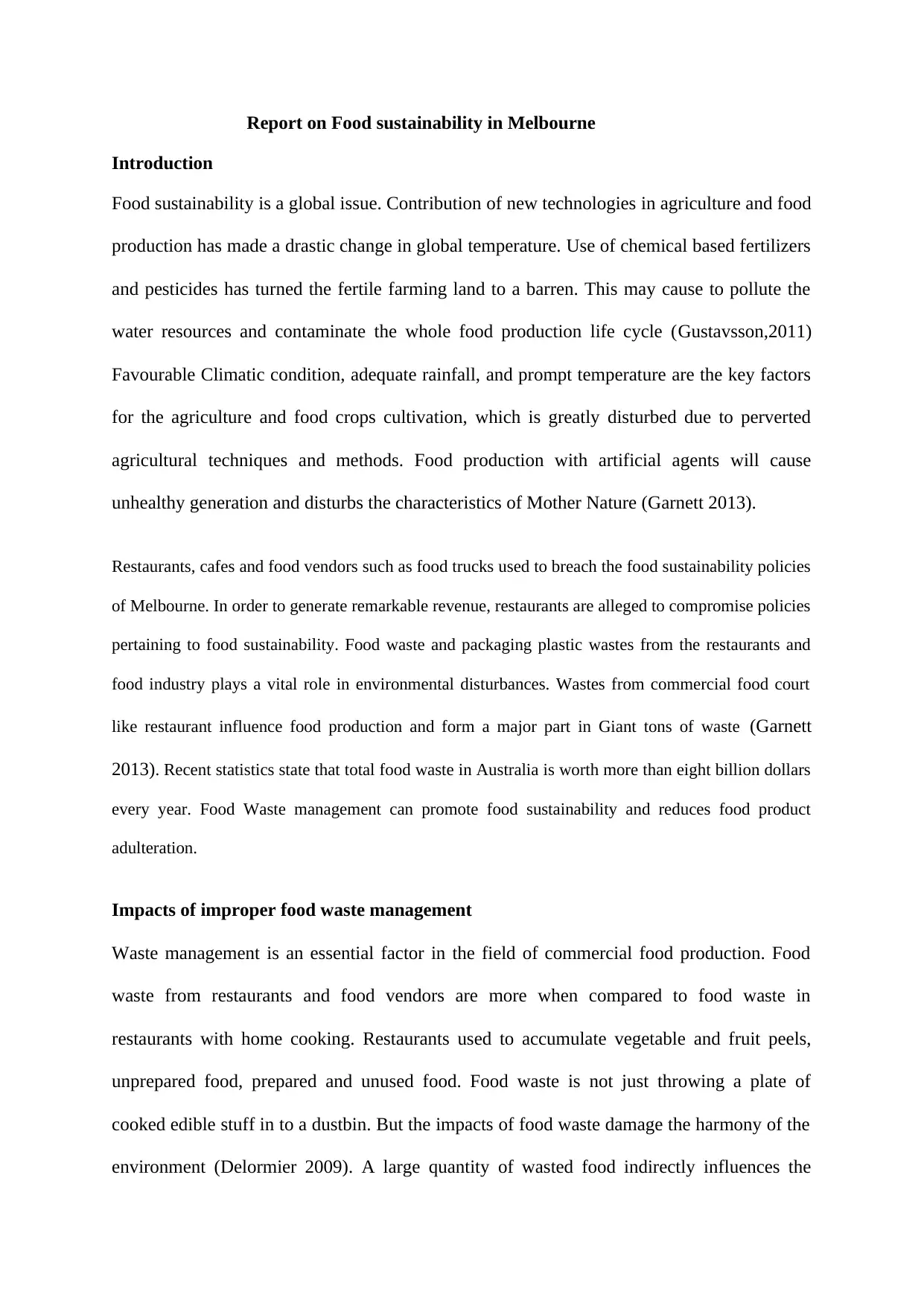
Report on Food sustainability in Melbourne
Introduction
Food sustainability is a global issue. Contribution of new technologies in agriculture and food
production has made a drastic change in global temperature. Use of chemical based fertilizers
and pesticides has turned the fertile farming land to a barren. This may cause to pollute the
water resources and contaminate the whole food production life cycle (Gustavsson,2011)
Favourable Climatic condition, adequate rainfall, and prompt temperature are the key factors
for the agriculture and food crops cultivation, which is greatly disturbed due to perverted
agricultural techniques and methods. Food production with artificial agents will cause
unhealthy generation and disturbs the characteristics of Mother Nature (Garnett 2013).
Restaurants, cafes and food vendors such as food trucks used to breach the food sustainability policies
of Melbourne. In order to generate remarkable revenue, restaurants are alleged to compromise policies
pertaining to food sustainability. Food waste and packaging plastic wastes from the restaurants and
food industry plays a vital role in environmental disturbances. Wastes from commercial food court
like restaurant influence food production and form a major part in Giant tons of waste (Garnett
2013). Recent statistics state that total food waste in Australia is worth more than eight billion dollars
every year. Food Waste management can promote food sustainability and reduces food product
adulteration.
Impacts of improper food waste management
Waste management is an essential factor in the field of commercial food production. Food
waste from restaurants and food vendors are more when compared to food waste in
restaurants with home cooking. Restaurants used to accumulate vegetable and fruit peels,
unprepared food, prepared and unused food. Food waste is not just throwing a plate of
cooked edible stuff in to a dustbin. But the impacts of food waste damage the harmony of the
environment (Delormier 2009). A large quantity of wasted food indirectly influences the
Introduction
Food sustainability is a global issue. Contribution of new technologies in agriculture and food
production has made a drastic change in global temperature. Use of chemical based fertilizers
and pesticides has turned the fertile farming land to a barren. This may cause to pollute the
water resources and contaminate the whole food production life cycle (Gustavsson,2011)
Favourable Climatic condition, adequate rainfall, and prompt temperature are the key factors
for the agriculture and food crops cultivation, which is greatly disturbed due to perverted
agricultural techniques and methods. Food production with artificial agents will cause
unhealthy generation and disturbs the characteristics of Mother Nature (Garnett 2013).
Restaurants, cafes and food vendors such as food trucks used to breach the food sustainability policies
of Melbourne. In order to generate remarkable revenue, restaurants are alleged to compromise policies
pertaining to food sustainability. Food waste and packaging plastic wastes from the restaurants and
food industry plays a vital role in environmental disturbances. Wastes from commercial food court
like restaurant influence food production and form a major part in Giant tons of waste (Garnett
2013). Recent statistics state that total food waste in Australia is worth more than eight billion dollars
every year. Food Waste management can promote food sustainability and reduces food product
adulteration.
Impacts of improper food waste management
Waste management is an essential factor in the field of commercial food production. Food
waste from restaurants and food vendors are more when compared to food waste in
restaurants with home cooking. Restaurants used to accumulate vegetable and fruit peels,
unprepared food, prepared and unused food. Food waste is not just throwing a plate of
cooked edible stuff in to a dustbin. But the impacts of food waste damage the harmony of the
environment (Delormier 2009). A large quantity of wasted food indirectly influences the
Secure Best Marks with AI Grader
Need help grading? Try our AI Grader for instant feedback on your assignments.
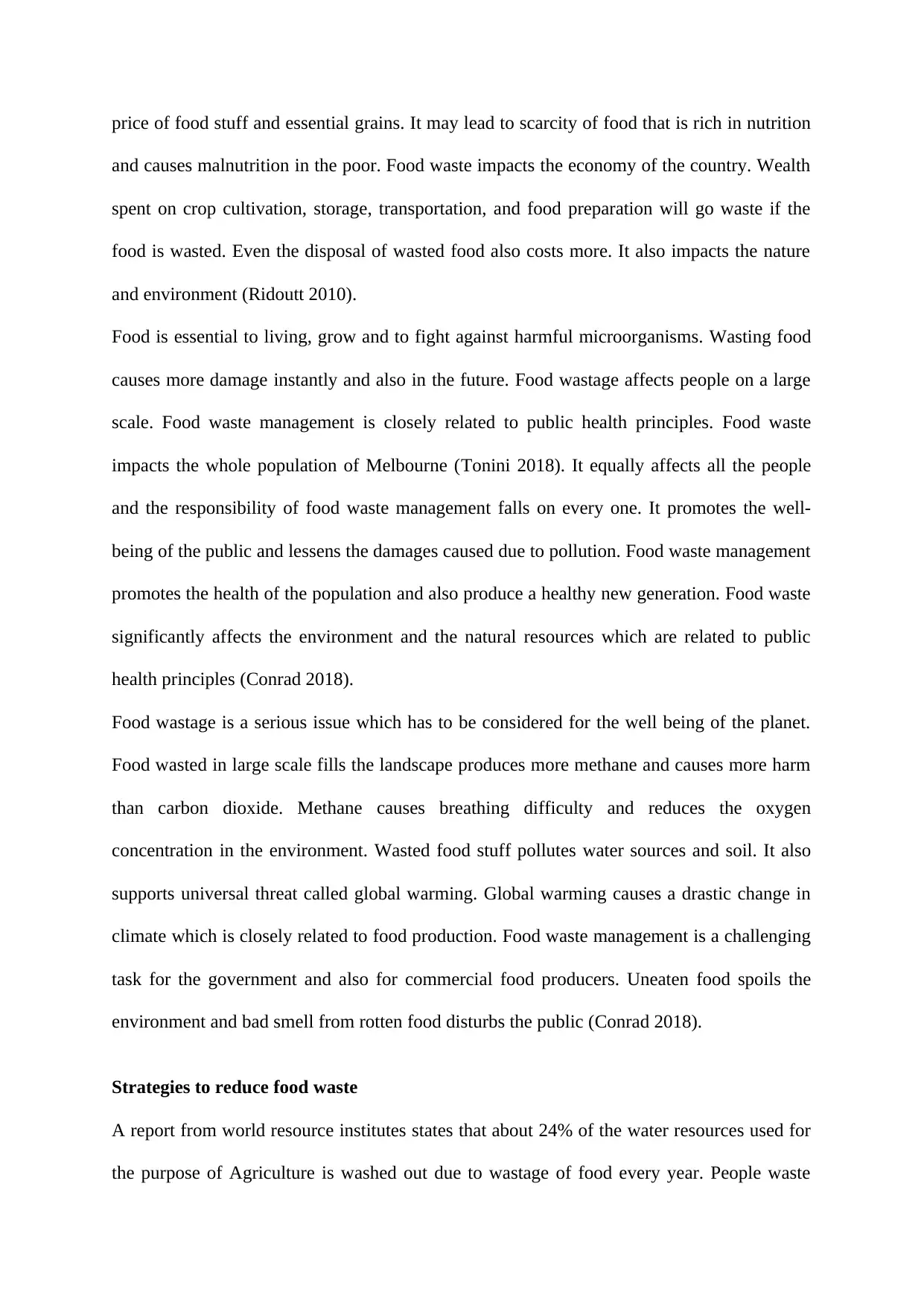
price of food stuff and essential grains. It may lead to scarcity of food that is rich in nutrition
and causes malnutrition in the poor. Food waste impacts the economy of the country. Wealth
spent on crop cultivation, storage, transportation, and food preparation will go waste if the
food is wasted. Even the disposal of wasted food also costs more. It also impacts the nature
and environment (Ridoutt 2010).
Food is essential to living, grow and to fight against harmful microorganisms. Wasting food
causes more damage instantly and also in the future. Food wastage affects people on a large
scale. Food waste management is closely related to public health principles. Food waste
impacts the whole population of Melbourne (Tonini 2018). It equally affects all the people
and the responsibility of food waste management falls on every one. It promotes the well-
being of the public and lessens the damages caused due to pollution. Food waste management
promotes the health of the population and also produce a healthy new generation. Food waste
significantly affects the environment and the natural resources which are related to public
health principles (Conrad 2018).
Food wastage is a serious issue which has to be considered for the well being of the planet.
Food wasted in large scale fills the landscape produces more methane and causes more harm
than carbon dioxide. Methane causes breathing difficulty and reduces the oxygen
concentration in the environment. Wasted food stuff pollutes water sources and soil. It also
supports universal threat called global warming. Global warming causes a drastic change in
climate which is closely related to food production. Food waste management is a challenging
task for the government and also for commercial food producers. Uneaten food spoils the
environment and bad smell from rotten food disturbs the public (Conrad 2018).
Strategies to reduce food waste
A report from world resource institutes states that about 24% of the water resources used for
the purpose of Agriculture is washed out due to wastage of food every year. People waste
and causes malnutrition in the poor. Food waste impacts the economy of the country. Wealth
spent on crop cultivation, storage, transportation, and food preparation will go waste if the
food is wasted. Even the disposal of wasted food also costs more. It also impacts the nature
and environment (Ridoutt 2010).
Food is essential to living, grow and to fight against harmful microorganisms. Wasting food
causes more damage instantly and also in the future. Food wastage affects people on a large
scale. Food waste management is closely related to public health principles. Food waste
impacts the whole population of Melbourne (Tonini 2018). It equally affects all the people
and the responsibility of food waste management falls on every one. It promotes the well-
being of the public and lessens the damages caused due to pollution. Food waste management
promotes the health of the population and also produce a healthy new generation. Food waste
significantly affects the environment and the natural resources which are related to public
health principles (Conrad 2018).
Food wastage is a serious issue which has to be considered for the well being of the planet.
Food wasted in large scale fills the landscape produces more methane and causes more harm
than carbon dioxide. Methane causes breathing difficulty and reduces the oxygen
concentration in the environment. Wasted food stuff pollutes water sources and soil. It also
supports universal threat called global warming. Global warming causes a drastic change in
climate which is closely related to food production. Food waste management is a challenging
task for the government and also for commercial food producers. Uneaten food spoils the
environment and bad smell from rotten food disturbs the public (Conrad 2018).
Strategies to reduce food waste
A report from world resource institutes states that about 24% of the water resources used for
the purpose of Agriculture is washed out due to wastage of food every year. People waste
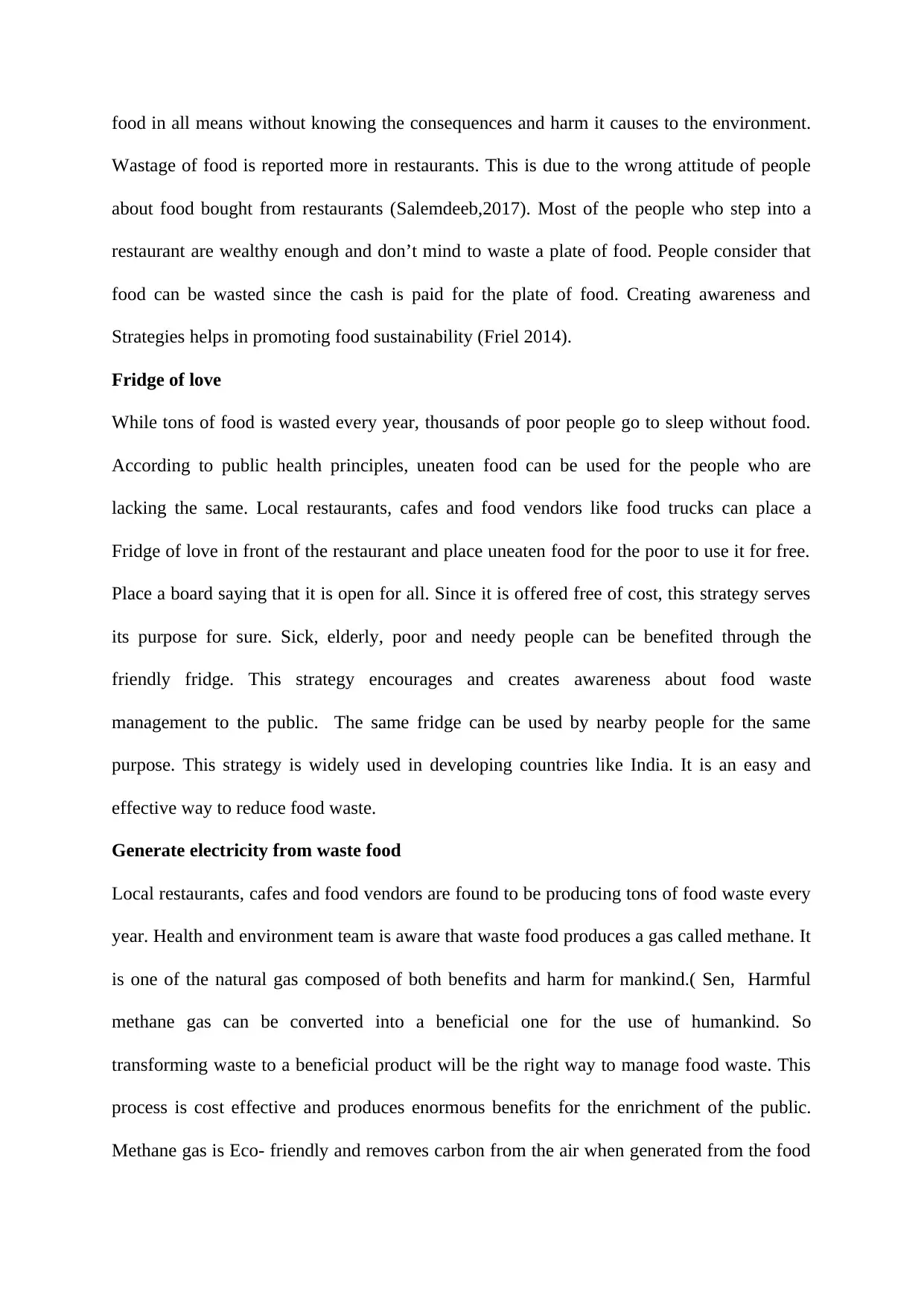
food in all means without knowing the consequences and harm it causes to the environment.
Wastage of food is reported more in restaurants. This is due to the wrong attitude of people
about food bought from restaurants (Salemdeeb,2017). Most of the people who step into a
restaurant are wealthy enough and don’t mind to waste a plate of food. People consider that
food can be wasted since the cash is paid for the plate of food. Creating awareness and
Strategies helps in promoting food sustainability (Friel 2014).
Fridge of love
While tons of food is wasted every year, thousands of poor people go to sleep without food.
According to public health principles, uneaten food can be used for the people who are
lacking the same. Local restaurants, cafes and food vendors like food trucks can place a
Fridge of love in front of the restaurant and place uneaten food for the poor to use it for free.
Place a board saying that it is open for all. Since it is offered free of cost, this strategy serves
its purpose for sure. Sick, elderly, poor and needy people can be benefited through the
friendly fridge. This strategy encourages and creates awareness about food waste
management to the public. The same fridge can be used by nearby people for the same
purpose. This strategy is widely used in developing countries like India. It is an easy and
effective way to reduce food waste.
Generate electricity from waste food
Local restaurants, cafes and food vendors are found to be producing tons of food waste every
year. Health and environment team is aware that waste food produces a gas called methane. It
is one of the natural gas composed of both benefits and harm for mankind.( Sen, Harmful
methane gas can be converted into a beneficial one for the use of humankind. So
transforming waste to a beneficial product will be the right way to manage food waste. This
process is cost effective and produces enormous benefits for the enrichment of the public.
Methane gas is Eco- friendly and removes carbon from the air when generated from the food
Wastage of food is reported more in restaurants. This is due to the wrong attitude of people
about food bought from restaurants (Salemdeeb,2017). Most of the people who step into a
restaurant are wealthy enough and don’t mind to waste a plate of food. People consider that
food can be wasted since the cash is paid for the plate of food. Creating awareness and
Strategies helps in promoting food sustainability (Friel 2014).
Fridge of love
While tons of food is wasted every year, thousands of poor people go to sleep without food.
According to public health principles, uneaten food can be used for the people who are
lacking the same. Local restaurants, cafes and food vendors like food trucks can place a
Fridge of love in front of the restaurant and place uneaten food for the poor to use it for free.
Place a board saying that it is open for all. Since it is offered free of cost, this strategy serves
its purpose for sure. Sick, elderly, poor and needy people can be benefited through the
friendly fridge. This strategy encourages and creates awareness about food waste
management to the public. The same fridge can be used by nearby people for the same
purpose. This strategy is widely used in developing countries like India. It is an easy and
effective way to reduce food waste.
Generate electricity from waste food
Local restaurants, cafes and food vendors are found to be producing tons of food waste every
year. Health and environment team is aware that waste food produces a gas called methane. It
is one of the natural gas composed of both benefits and harm for mankind.( Sen, Harmful
methane gas can be converted into a beneficial one for the use of humankind. So
transforming waste to a beneficial product will be the right way to manage food waste. This
process is cost effective and produces enormous benefits for the enrichment of the public.
Methane gas is Eco- friendly and removes carbon from the air when generated from the food
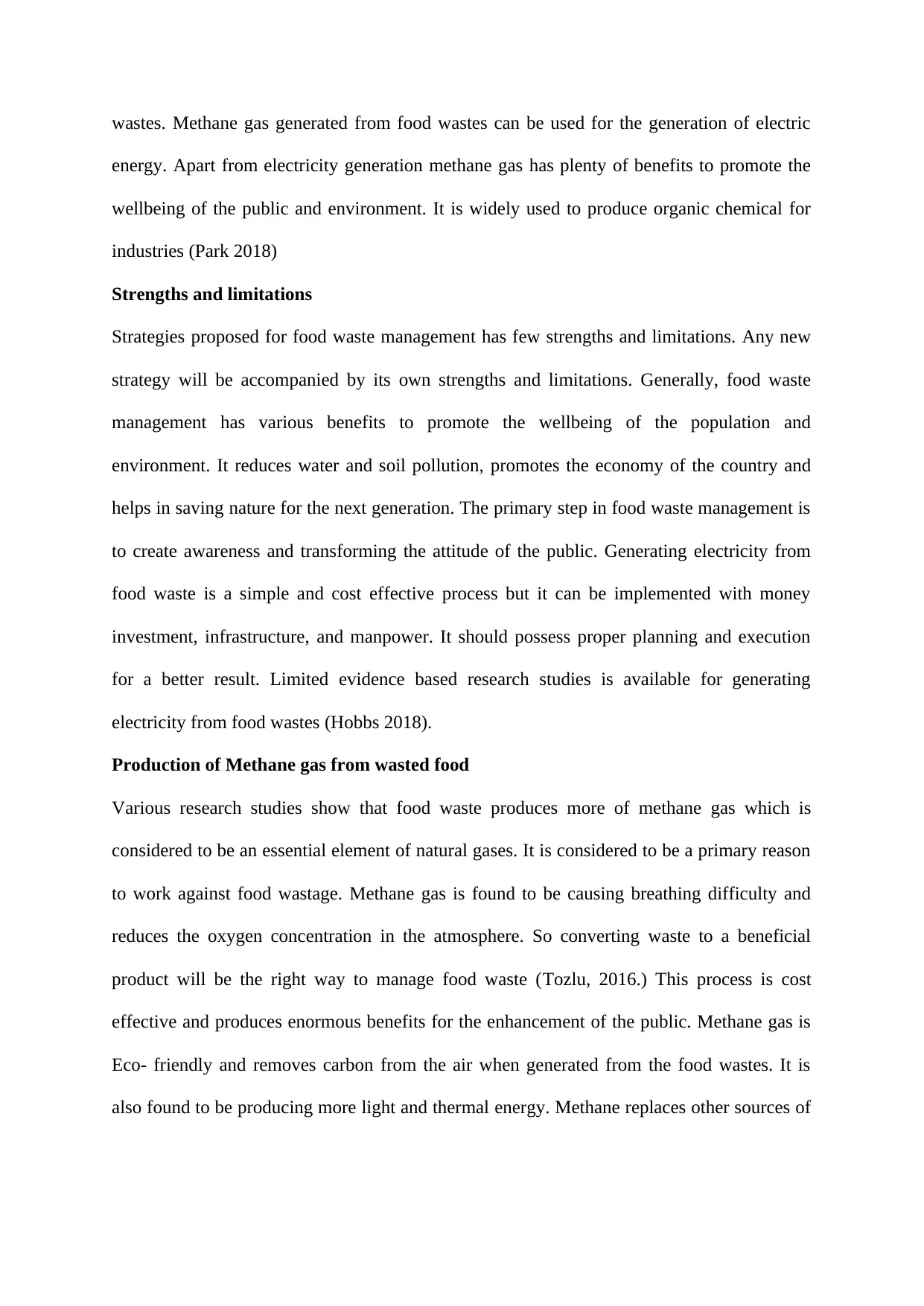
wastes. Methane gas generated from food wastes can be used for the generation of electric
energy. Apart from electricity generation methane gas has plenty of benefits to promote the
wellbeing of the public and environment. It is widely used to produce organic chemical for
industries (Park 2018)
Strengths and limitations
Strategies proposed for food waste management has few strengths and limitations. Any new
strategy will be accompanied by its own strengths and limitations. Generally, food waste
management has various benefits to promote the wellbeing of the population and
environment. It reduces water and soil pollution, promotes the economy of the country and
helps in saving nature for the next generation. The primary step in food waste management is
to create awareness and transforming the attitude of the public. Generating electricity from
food waste is a simple and cost effective process but it can be implemented with money
investment, infrastructure, and manpower. It should possess proper planning and execution
for a better result. Limited evidence based research studies is available for generating
electricity from food wastes (Hobbs 2018).
Production of Methane gas from wasted food
Various research studies show that food waste produces more of methane gas which is
considered to be an essential element of natural gases. It is considered to be a primary reason
to work against food wastage. Methane gas is found to be causing breathing difficulty and
reduces the oxygen concentration in the atmosphere. So converting waste to a beneficial
product will be the right way to manage food waste (Tozlu, 2016.) This process is cost
effective and produces enormous benefits for the enhancement of the public. Methane gas is
Eco- friendly and removes carbon from the air when generated from the food wastes. It is
also found to be producing more light and thermal energy. Methane replaces other sources of
energy. Apart from electricity generation methane gas has plenty of benefits to promote the
wellbeing of the public and environment. It is widely used to produce organic chemical for
industries (Park 2018)
Strengths and limitations
Strategies proposed for food waste management has few strengths and limitations. Any new
strategy will be accompanied by its own strengths and limitations. Generally, food waste
management has various benefits to promote the wellbeing of the population and
environment. It reduces water and soil pollution, promotes the economy of the country and
helps in saving nature for the next generation. The primary step in food waste management is
to create awareness and transforming the attitude of the public. Generating electricity from
food waste is a simple and cost effective process but it can be implemented with money
investment, infrastructure, and manpower. It should possess proper planning and execution
for a better result. Limited evidence based research studies is available for generating
electricity from food wastes (Hobbs 2018).
Production of Methane gas from wasted food
Various research studies show that food waste produces more of methane gas which is
considered to be an essential element of natural gases. It is considered to be a primary reason
to work against food wastage. Methane gas is found to be causing breathing difficulty and
reduces the oxygen concentration in the atmosphere. So converting waste to a beneficial
product will be the right way to manage food waste (Tozlu, 2016.) This process is cost
effective and produces enormous benefits for the enhancement of the public. Methane gas is
Eco- friendly and removes carbon from the air when generated from the food wastes. It is
also found to be producing more light and thermal energy. Methane replaces other sources of
Secure Best Marks with AI Grader
Need help grading? Try our AI Grader for instant feedback on your assignments.
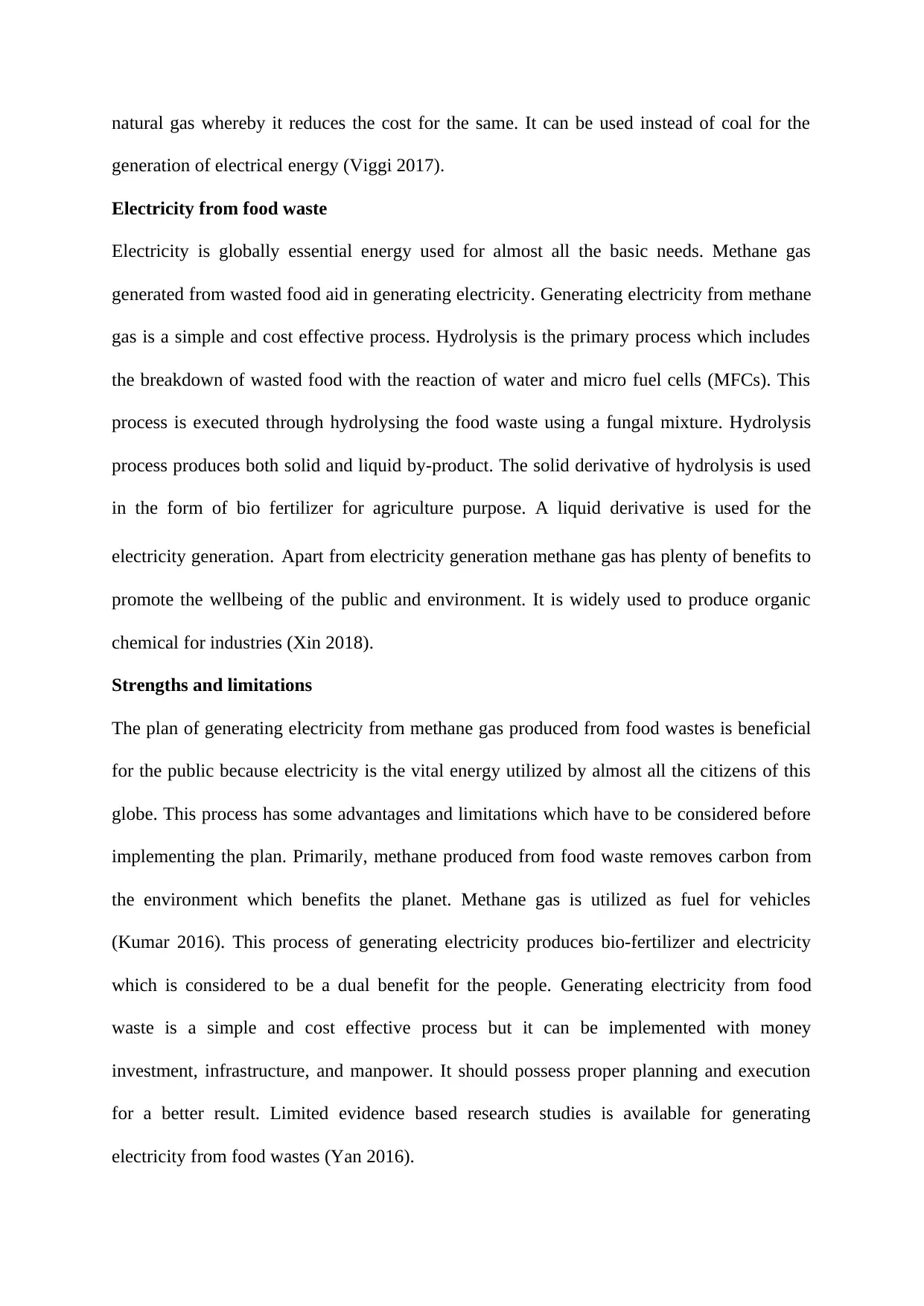
natural gas whereby it reduces the cost for the same. It can be used instead of coal for the
generation of electrical energy (Viggi 2017).
Electricity from food waste
Electricity is globally essential energy used for almost all the basic needs. Methane gas
generated from wasted food aid in generating electricity. Generating electricity from methane
gas is a simple and cost effective process. Hydrolysis is the primary process which includes
the breakdown of wasted food with the reaction of water and micro fuel cells (MFCs). This
process is executed through hydrolysing the food waste using a fungal mixture. Hydrolysis
process produces both solid and liquid by-product. The solid derivative of hydrolysis is used
in the form of bio fertilizer for agriculture purpose. A liquid derivative is used for the
electricity generation. Apart from electricity generation methane gas has plenty of benefits to
promote the wellbeing of the public and environment. It is widely used to produce organic
chemical for industries (Xin 2018).
Strengths and limitations
The plan of generating electricity from methane gas produced from food wastes is beneficial
for the public because electricity is the vital energy utilized by almost all the citizens of this
globe. This process has some advantages and limitations which have to be considered before
implementing the plan. Primarily, methane produced from food waste removes carbon from
the environment which benefits the planet. Methane gas is utilized as fuel for vehicles
(Kumar 2016). This process of generating electricity produces bio-fertilizer and electricity
which is considered to be a dual benefit for the people. Generating electricity from food
waste is a simple and cost effective process but it can be implemented with money
investment, infrastructure, and manpower. It should possess proper planning and execution
for a better result. Limited evidence based research studies is available for generating
electricity from food wastes (Yan 2016).
generation of electrical energy (Viggi 2017).
Electricity from food waste
Electricity is globally essential energy used for almost all the basic needs. Methane gas
generated from wasted food aid in generating electricity. Generating electricity from methane
gas is a simple and cost effective process. Hydrolysis is the primary process which includes
the breakdown of wasted food with the reaction of water and micro fuel cells (MFCs). This
process is executed through hydrolysing the food waste using a fungal mixture. Hydrolysis
process produces both solid and liquid by-product. The solid derivative of hydrolysis is used
in the form of bio fertilizer for agriculture purpose. A liquid derivative is used for the
electricity generation. Apart from electricity generation methane gas has plenty of benefits to
promote the wellbeing of the public and environment. It is widely used to produce organic
chemical for industries (Xin 2018).
Strengths and limitations
The plan of generating electricity from methane gas produced from food wastes is beneficial
for the public because electricity is the vital energy utilized by almost all the citizens of this
globe. This process has some advantages and limitations which have to be considered before
implementing the plan. Primarily, methane produced from food waste removes carbon from
the environment which benefits the planet. Methane gas is utilized as fuel for vehicles
(Kumar 2016). This process of generating electricity produces bio-fertilizer and electricity
which is considered to be a dual benefit for the people. Generating electricity from food
waste is a simple and cost effective process but it can be implemented with money
investment, infrastructure, and manpower. It should possess proper planning and execution
for a better result. Limited evidence based research studies is available for generating
electricity from food wastes (Yan 2016).
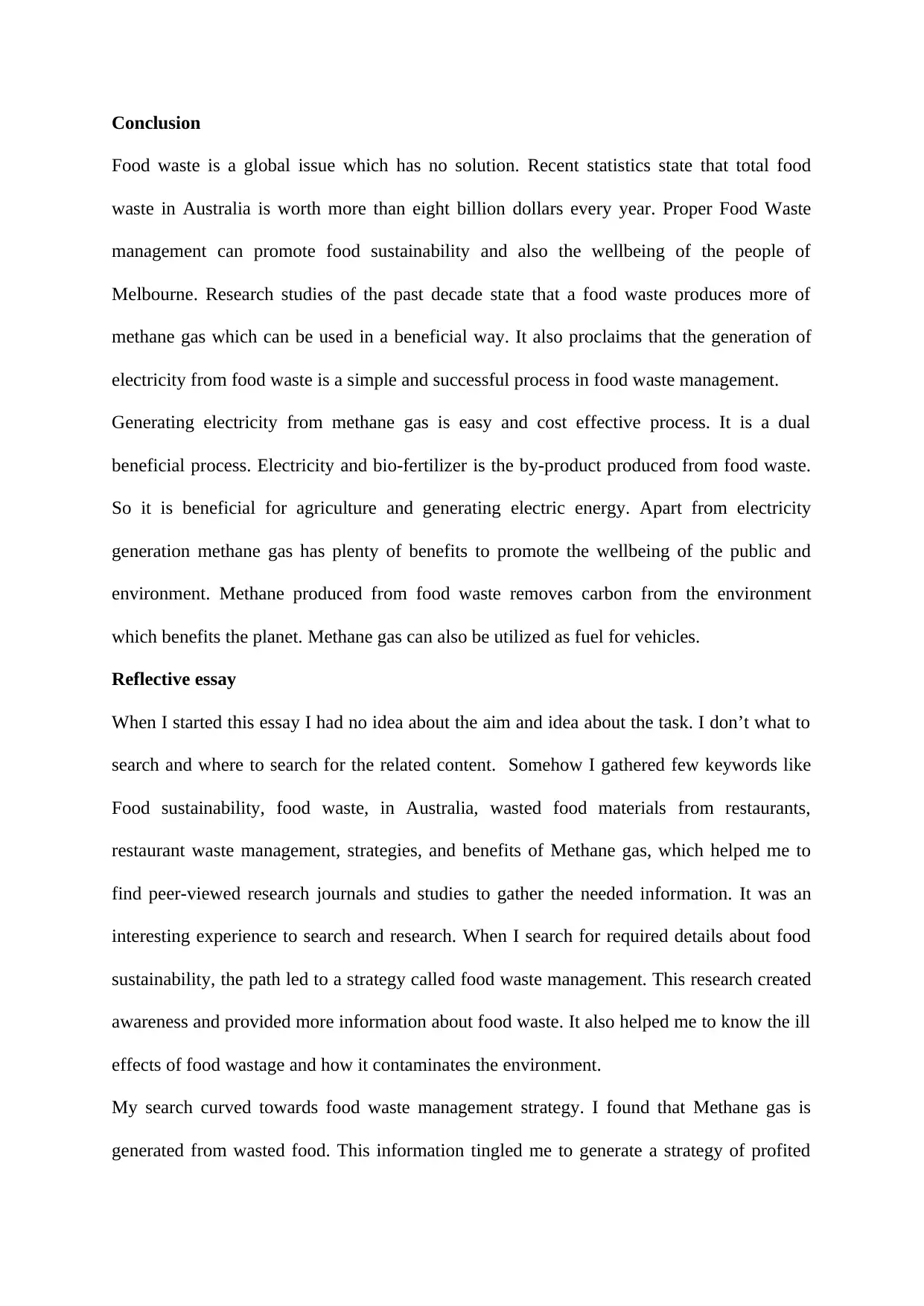
Conclusion
Food waste is a global issue which has no solution. Recent statistics state that total food
waste in Australia is worth more than eight billion dollars every year. Proper Food Waste
management can promote food sustainability and also the wellbeing of the people of
Melbourne. Research studies of the past decade state that a food waste produces more of
methane gas which can be used in a beneficial way. It also proclaims that the generation of
electricity from food waste is a simple and successful process in food waste management.
Generating electricity from methane gas is easy and cost effective process. It is a dual
beneficial process. Electricity and bio-fertilizer is the by-product produced from food waste.
So it is beneficial for agriculture and generating electric energy. Apart from electricity
generation methane gas has plenty of benefits to promote the wellbeing of the public and
environment. Methane produced from food waste removes carbon from the environment
which benefits the planet. Methane gas can also be utilized as fuel for vehicles.
Reflective essay
When I started this essay I had no idea about the aim and idea about the task. I don’t what to
search and where to search for the related content. Somehow I gathered few keywords like
Food sustainability, food waste, in Australia, wasted food materials from restaurants,
restaurant waste management, strategies, and benefits of Methane gas, which helped me to
find peer-viewed research journals and studies to gather the needed information. It was an
interesting experience to search and research. When I search for required details about food
sustainability, the path led to a strategy called food waste management. This research created
awareness and provided more information about food waste. It also helped me to know the ill
effects of food wastage and how it contaminates the environment.
My search curved towards food waste management strategy. I found that Methane gas is
generated from wasted food. This information tingled me to generate a strategy of profited
Food waste is a global issue which has no solution. Recent statistics state that total food
waste in Australia is worth more than eight billion dollars every year. Proper Food Waste
management can promote food sustainability and also the wellbeing of the people of
Melbourne. Research studies of the past decade state that a food waste produces more of
methane gas which can be used in a beneficial way. It also proclaims that the generation of
electricity from food waste is a simple and successful process in food waste management.
Generating electricity from methane gas is easy and cost effective process. It is a dual
beneficial process. Electricity and bio-fertilizer is the by-product produced from food waste.
So it is beneficial for agriculture and generating electric energy. Apart from electricity
generation methane gas has plenty of benefits to promote the wellbeing of the public and
environment. Methane produced from food waste removes carbon from the environment
which benefits the planet. Methane gas can also be utilized as fuel for vehicles.
Reflective essay
When I started this essay I had no idea about the aim and idea about the task. I don’t what to
search and where to search for the related content. Somehow I gathered few keywords like
Food sustainability, food waste, in Australia, wasted food materials from restaurants,
restaurant waste management, strategies, and benefits of Methane gas, which helped me to
find peer-viewed research journals and studies to gather the needed information. It was an
interesting experience to search and research. When I search for required details about food
sustainability, the path led to a strategy called food waste management. This research created
awareness and provided more information about food waste. It also helped me to know the ill
effects of food wastage and how it contaminates the environment.
My search curved towards food waste management strategy. I found that Methane gas is
generated from wasted food. This information tingled me to generate a strategy of profited
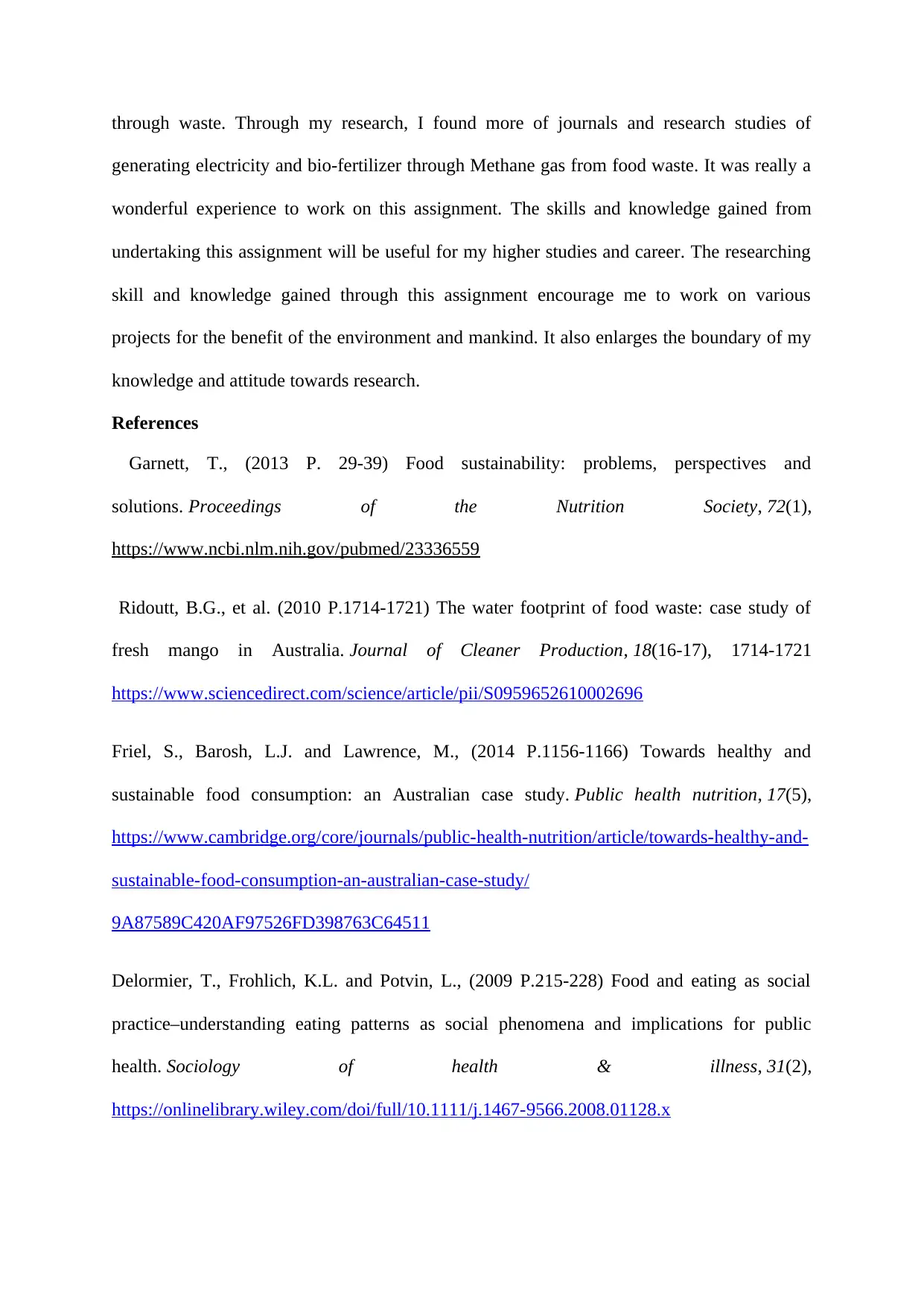
through waste. Through my research, I found more of journals and research studies of
generating electricity and bio-fertilizer through Methane gas from food waste. It was really a
wonderful experience to work on this assignment. The skills and knowledge gained from
undertaking this assignment will be useful for my higher studies and career. The researching
skill and knowledge gained through this assignment encourage me to work on various
projects for the benefit of the environment and mankind. It also enlarges the boundary of my
knowledge and attitude towards research.
References
Garnett, T., (2013 P. 29-39) Food sustainability: problems, perspectives and
solutions. Proceedings of the Nutrition Society, 72(1),
https://www.ncbi.nlm.nih.gov/pubmed/23336559
Ridoutt, B.G., et al. (2010 P.1714-1721) The water footprint of food waste: case study of
fresh mango in Australia. Journal of Cleaner Production, 18(16-17), 1714-1721
https://www.sciencedirect.com/science/article/pii/S0959652610002696
Friel, S., Barosh, L.J. and Lawrence, M., (2014 P.1156-1166) Towards healthy and
sustainable food consumption: an Australian case study. Public health nutrition, 17(5),
https://www.cambridge.org/core/journals/public-health-nutrition/article/towards-healthy-and-
sustainable-food-consumption-an-australian-case-study/
9A87589C420AF97526FD398763C64511
Delormier, T., Frohlich, K.L. and Potvin, L., (2009 P.215-228) Food and eating as social
practice–understanding eating patterns as social phenomena and implications for public
health. Sociology of health & illness, 31(2),
https://onlinelibrary.wiley.com/doi/full/10.1111/j.1467-9566.2008.01128.x
generating electricity and bio-fertilizer through Methane gas from food waste. It was really a
wonderful experience to work on this assignment. The skills and knowledge gained from
undertaking this assignment will be useful for my higher studies and career. The researching
skill and knowledge gained through this assignment encourage me to work on various
projects for the benefit of the environment and mankind. It also enlarges the boundary of my
knowledge and attitude towards research.
References
Garnett, T., (2013 P. 29-39) Food sustainability: problems, perspectives and
solutions. Proceedings of the Nutrition Society, 72(1),
https://www.ncbi.nlm.nih.gov/pubmed/23336559
Ridoutt, B.G., et al. (2010 P.1714-1721) The water footprint of food waste: case study of
fresh mango in Australia. Journal of Cleaner Production, 18(16-17), 1714-1721
https://www.sciencedirect.com/science/article/pii/S0959652610002696
Friel, S., Barosh, L.J. and Lawrence, M., (2014 P.1156-1166) Towards healthy and
sustainable food consumption: an Australian case study. Public health nutrition, 17(5),
https://www.cambridge.org/core/journals/public-health-nutrition/article/towards-healthy-and-
sustainable-food-consumption-an-australian-case-study/
9A87589C420AF97526FD398763C64511
Delormier, T., Frohlich, K.L. and Potvin, L., (2009 P.215-228) Food and eating as social
practice–understanding eating patterns as social phenomena and implications for public
health. Sociology of health & illness, 31(2),
https://onlinelibrary.wiley.com/doi/full/10.1111/j.1467-9566.2008.01128.x
Paraphrase This Document
Need a fresh take? Get an instant paraphrase of this document with our AI Paraphraser
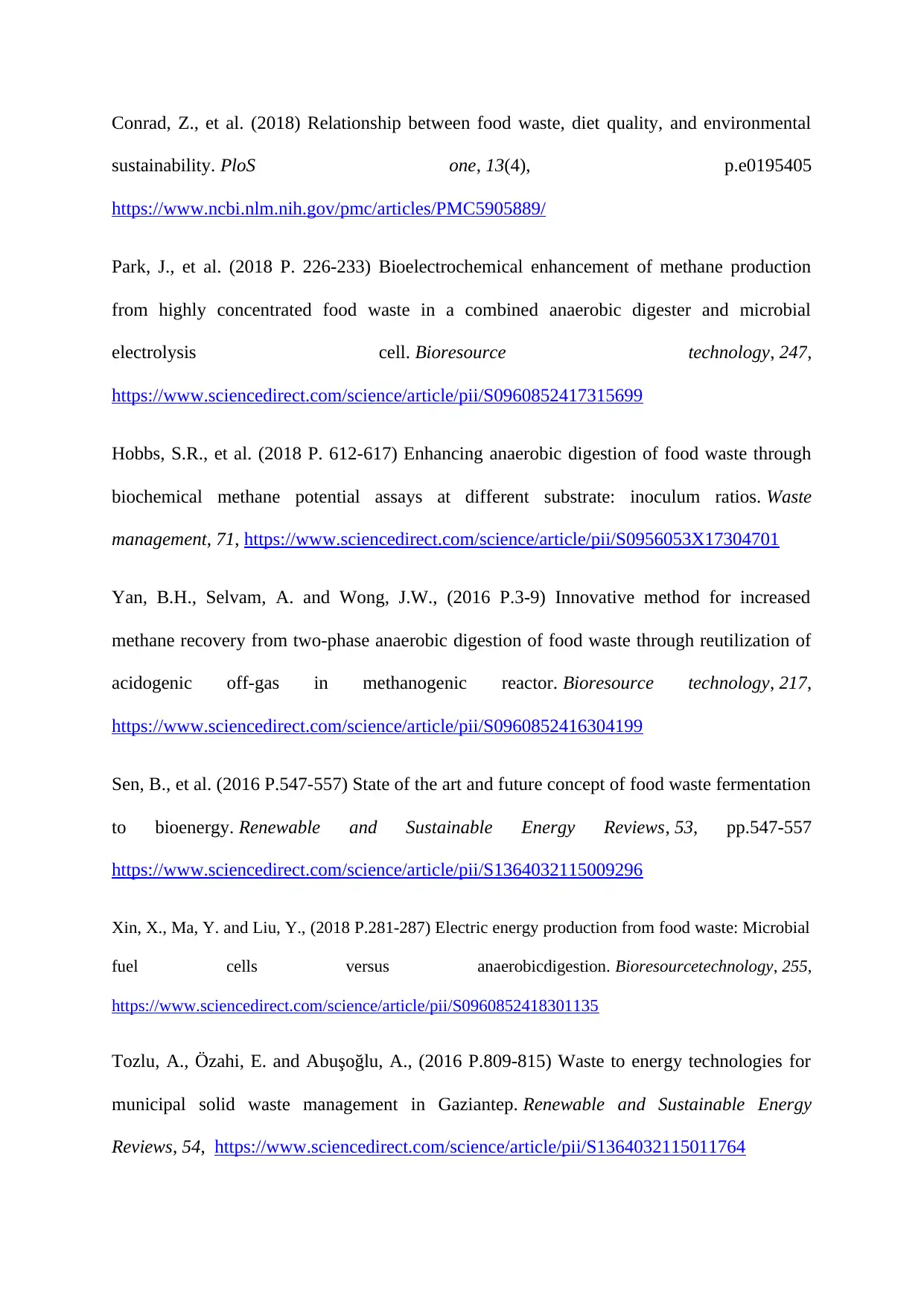
Conrad, Z., et al. (2018) Relationship between food waste, diet quality, and environmental
sustainability. PloS one, 13(4), p.e0195405
https://www.ncbi.nlm.nih.gov/pmc/articles/PMC5905889/
Park, J., et al. (2018 P. 226-233) Bioelectrochemical enhancement of methane production
from highly concentrated food waste in a combined anaerobic digester and microbial
electrolysis cell. Bioresource technology, 247,
https://www.sciencedirect.com/science/article/pii/S0960852417315699
Hobbs, S.R., et al. (2018 P. 612-617) Enhancing anaerobic digestion of food waste through
biochemical methane potential assays at different substrate: inoculum ratios. Waste
management, 71, https://www.sciencedirect.com/science/article/pii/S0956053X17304701
Yan, B.H., Selvam, A. and Wong, J.W., (2016 P.3-9) Innovative method for increased
methane recovery from two-phase anaerobic digestion of food waste through reutilization of
acidogenic off-gas in methanogenic reactor. Bioresource technology, 217,
https://www.sciencedirect.com/science/article/pii/S0960852416304199
Sen, B., et al. (2016 P.547-557) State of the art and future concept of food waste fermentation
to bioenergy. Renewable and Sustainable Energy Reviews, 53, pp.547-557
https://www.sciencedirect.com/science/article/pii/S1364032115009296
Xin, X., Ma, Y. and Liu, Y., (2018 P.281-287) Electric energy production from food waste: Microbial
fuel cells versus anaerobicdigestion. Bioresourcetechnology, 255,
https://www.sciencedirect.com/science/article/pii/S0960852418301135
Tozlu, A., Özahi, E. and Abuşoğlu, A., (2016 P.809-815) Waste to energy technologies for
municipal solid waste management in Gaziantep. Renewable and Sustainable Energy
Reviews, 54, https://www.sciencedirect.com/science/article/pii/S1364032115011764
sustainability. PloS one, 13(4), p.e0195405
https://www.ncbi.nlm.nih.gov/pmc/articles/PMC5905889/
Park, J., et al. (2018 P. 226-233) Bioelectrochemical enhancement of methane production
from highly concentrated food waste in a combined anaerobic digester and microbial
electrolysis cell. Bioresource technology, 247,
https://www.sciencedirect.com/science/article/pii/S0960852417315699
Hobbs, S.R., et al. (2018 P. 612-617) Enhancing anaerobic digestion of food waste through
biochemical methane potential assays at different substrate: inoculum ratios. Waste
management, 71, https://www.sciencedirect.com/science/article/pii/S0956053X17304701
Yan, B.H., Selvam, A. and Wong, J.W., (2016 P.3-9) Innovative method for increased
methane recovery from two-phase anaerobic digestion of food waste through reutilization of
acidogenic off-gas in methanogenic reactor. Bioresource technology, 217,
https://www.sciencedirect.com/science/article/pii/S0960852416304199
Sen, B., et al. (2016 P.547-557) State of the art and future concept of food waste fermentation
to bioenergy. Renewable and Sustainable Energy Reviews, 53, pp.547-557
https://www.sciencedirect.com/science/article/pii/S1364032115009296
Xin, X., Ma, Y. and Liu, Y., (2018 P.281-287) Electric energy production from food waste: Microbial
fuel cells versus anaerobicdigestion. Bioresourcetechnology, 255,
https://www.sciencedirect.com/science/article/pii/S0960852418301135
Tozlu, A., Özahi, E. and Abuşoğlu, A., (2016 P.809-815) Waste to energy technologies for
municipal solid waste management in Gaziantep. Renewable and Sustainable Energy
Reviews, 54, https://www.sciencedirect.com/science/article/pii/S1364032115011764
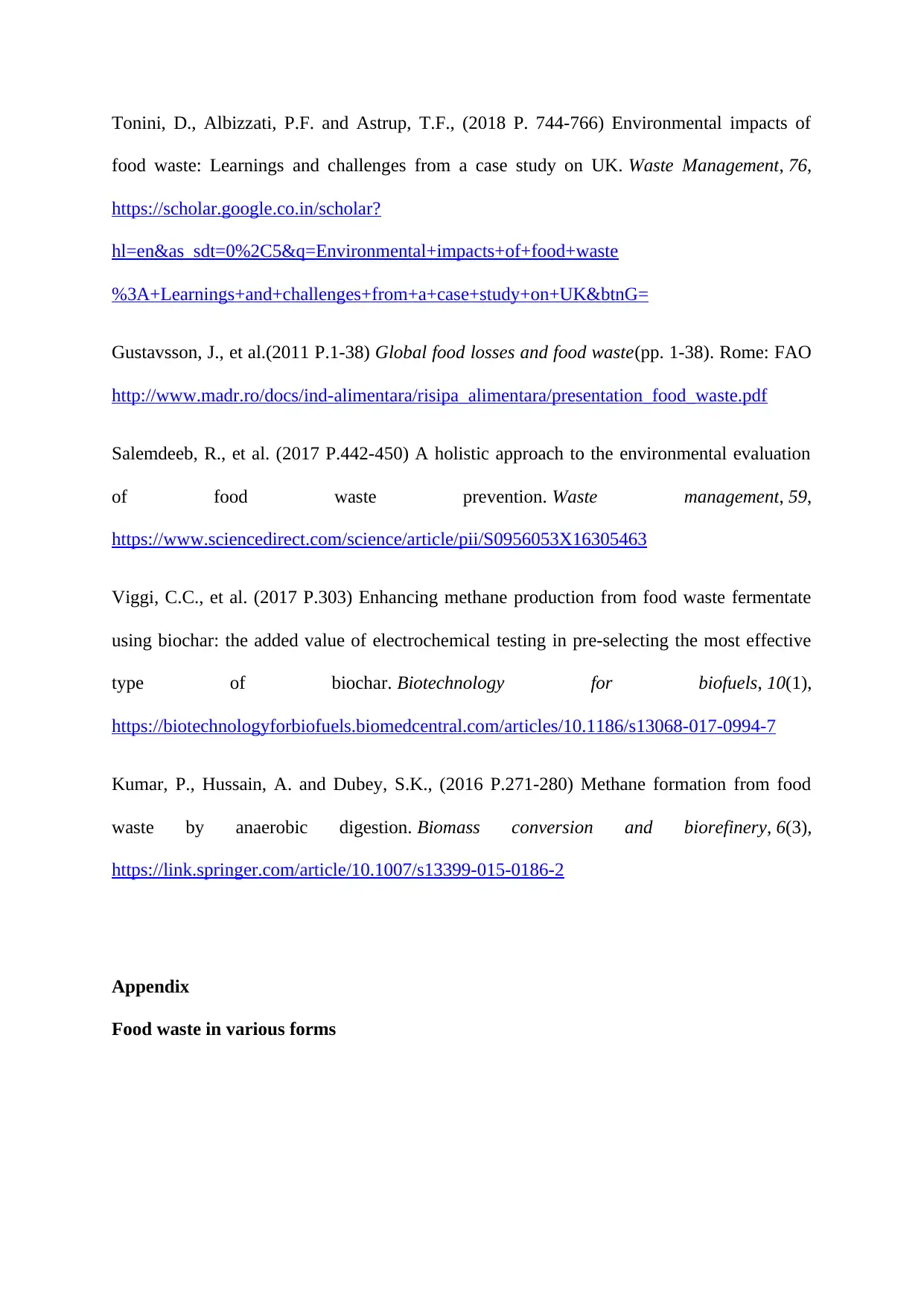
Tonini, D., Albizzati, P.F. and Astrup, T.F., (2018 P. 744-766) Environmental impacts of
food waste: Learnings and challenges from a case study on UK. Waste Management, 76,
https://scholar.google.co.in/scholar?
hl=en&as_sdt=0%2C5&q=Environmental+impacts+of+food+waste
%3A+Learnings+and+challenges+from+a+case+study+on+UK&btnG=
Gustavsson, J., et al.(2011 P.1-38) Global food losses and food waste(pp. 1-38). Rome: FAO
http://www.madr.ro/docs/ind-alimentara/risipa_alimentara/presentation_food_waste.pdf
Salemdeeb, R., et al. (2017 P.442-450) A holistic approach to the environmental evaluation
of food waste prevention. Waste management, 59,
https://www.sciencedirect.com/science/article/pii/S0956053X16305463
Viggi, C.C., et al. (2017 P.303) Enhancing methane production from food waste fermentate
using biochar: the added value of electrochemical testing in pre-selecting the most effective
type of biochar. Biotechnology for biofuels, 10(1),
https://biotechnologyforbiofuels.biomedcentral.com/articles/10.1186/s13068-017-0994-7
Kumar, P., Hussain, A. and Dubey, S.K., (2016 P.271-280) Methane formation from food
waste by anaerobic digestion. Biomass conversion and biorefinery, 6(3),
https://link.springer.com/article/10.1007/s13399-015-0186-2
Appendix
Food waste in various forms
food waste: Learnings and challenges from a case study on UK. Waste Management, 76,
https://scholar.google.co.in/scholar?
hl=en&as_sdt=0%2C5&q=Environmental+impacts+of+food+waste
%3A+Learnings+and+challenges+from+a+case+study+on+UK&btnG=
Gustavsson, J., et al.(2011 P.1-38) Global food losses and food waste(pp. 1-38). Rome: FAO
http://www.madr.ro/docs/ind-alimentara/risipa_alimentara/presentation_food_waste.pdf
Salemdeeb, R., et al. (2017 P.442-450) A holistic approach to the environmental evaluation
of food waste prevention. Waste management, 59,
https://www.sciencedirect.com/science/article/pii/S0956053X16305463
Viggi, C.C., et al. (2017 P.303) Enhancing methane production from food waste fermentate
using biochar: the added value of electrochemical testing in pre-selecting the most effective
type of biochar. Biotechnology for biofuels, 10(1),
https://biotechnologyforbiofuels.biomedcentral.com/articles/10.1186/s13068-017-0994-7
Kumar, P., Hussain, A. and Dubey, S.K., (2016 P.271-280) Methane formation from food
waste by anaerobic digestion. Biomass conversion and biorefinery, 6(3),
https://link.springer.com/article/10.1007/s13399-015-0186-2
Appendix
Food waste in various forms
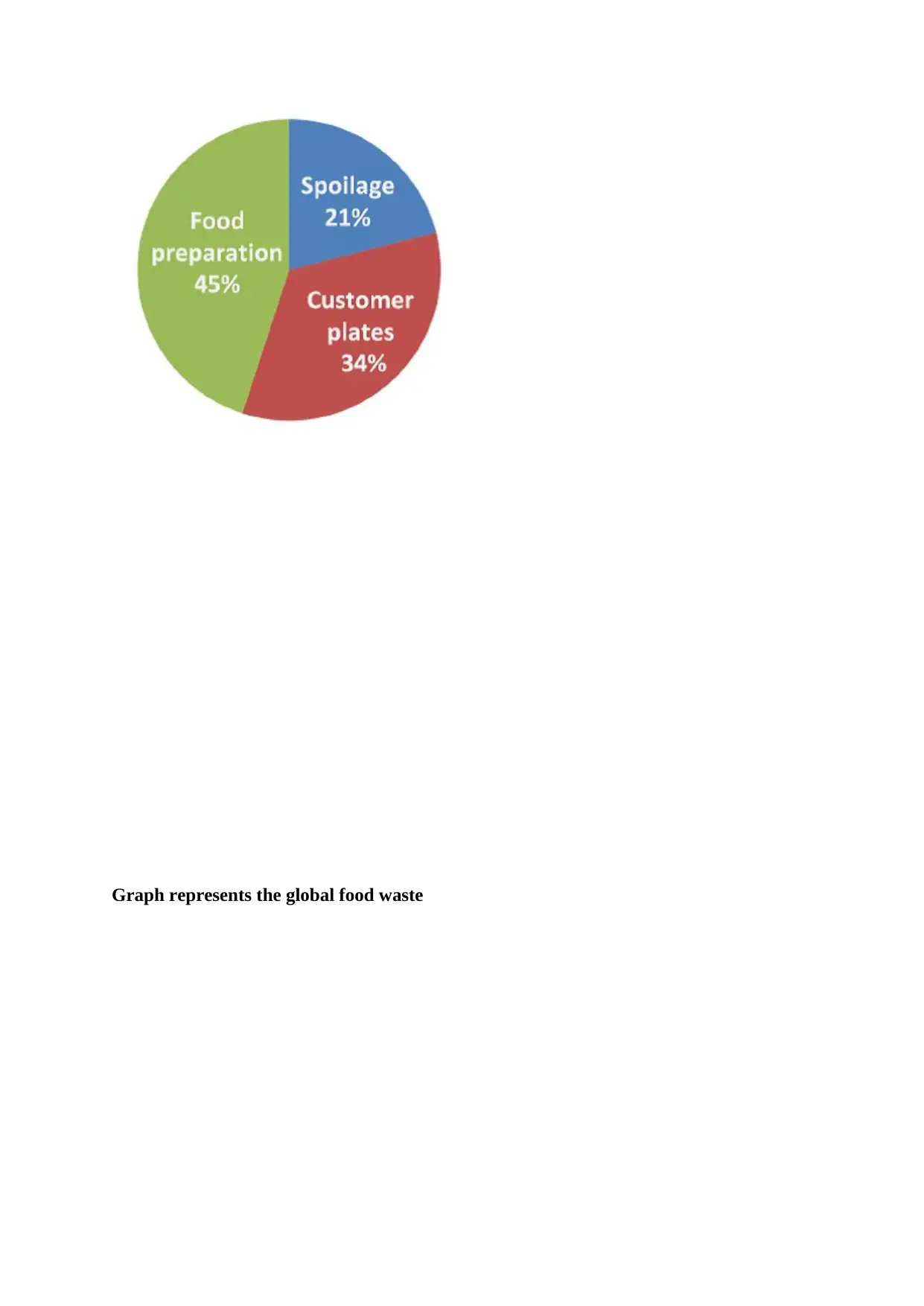
Graph represents the global food waste
Secure Best Marks with AI Grader
Need help grading? Try our AI Grader for instant feedback on your assignments.
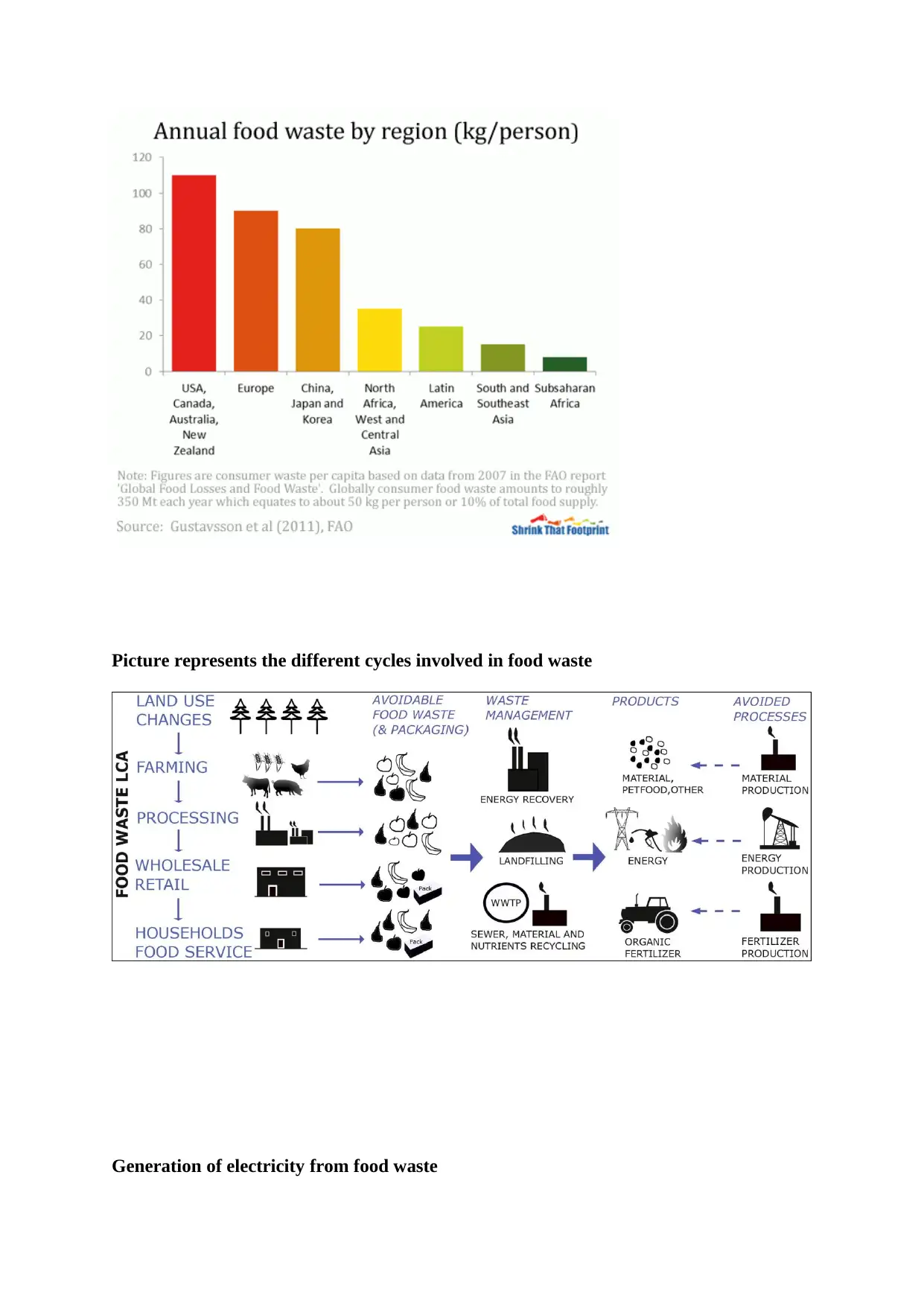
Picture represents the different cycles involved in food waste
Generation of electricity from food waste
Generation of electricity from food waste

.
1 out of 12
Related Documents
Your All-in-One AI-Powered Toolkit for Academic Success.
+13062052269
info@desklib.com
Available 24*7 on WhatsApp / Email
![[object Object]](/_next/static/media/star-bottom.7253800d.svg)
Unlock your academic potential
© 2024 | Zucol Services PVT LTD | All rights reserved.




